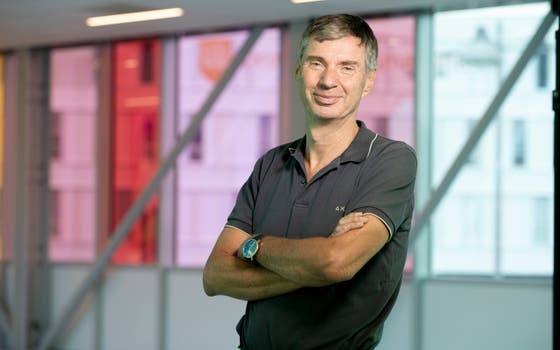Ronald de Krijger becomes professor of pathology

Ronald de Krijger has been appointed professor of Pathology of solid pediatric tumours at UMC Utrecht. In his new role, De Krijger aims to improve the translation of new developments within pathology to the care of children with cancer. 'More and more knowledge about tumours is becoming available from my field. We must use this knowledge as well as possible as a basis when determining the best treatment plan for a child.'
Ronald de Krijger is a pathologist at the Princess Máxima Centre. Every year, about 190 children in the Netherlands are diagnosed with solid tumours. These include, for example, neuroblastomas, kidney, liver and germ cell tumours. From the pathology, the type, and often also subtype, is determined. For solid tumours, this is usually done through a piece of tumour, a biopsy. This is examined not only by the pathologist, but also by the molecular biologists and bioinformaticians at the Máxima Children's Oncology Laboratory. Besides the diagnosis, the pathologist also shares information with the treating physicians that is important for the prognosis and for the nature and type of treatment. This information forms the basis for drawing up the most appropriate treatment plan.
Developments within pathology
Within pathology, research is conducted to improve existing, but also to find new methods and technologies. De Krijger: 'It is important that we in pathology keep up with the latest developments, so that we can make the right diagnosis and give the best advice based on as much reliable data as possible. For example, we are looking at how to use so-called immunohistochemical staining to show the presence and activity of immune cells in tumour tissue. This could help in choosing the most appropriate immunotherapy.'
Using artificial intelligence, De Krijger aims to improve and speed up analyses and hopes to gain new insights. 'By teaching the computer to recognise parts in the tumour, microscopic images of the tissue can be analysed automatically. This saves us a lot of time and because of automation, the process is less error prone.'
In addition, De Krijger sees opportunities in having the computer perform analyses independently. 'We collect enormous amounts of data. The computer may find connections that we did not see before, but which could help us in determining the best treatment plan for certain groups of children.'
Linking research and care
Pathologists participate in the ‘tumour board’. In this consultation, specialists from healthcare and research come together to arrive at the most suitable treatment plan for each child. 'The tumour board is a very good example of the Máxima as a research hospital. This is where clinic and research literally come together. As pathologists, we have a bridging function between the two groups, because we can translate developments from research, related to pathology, into clinical applications as quickly as possible. I therefore see it as my role to see how we can further strengthen the cooperation to function as a tumour board in the best possible way for the child.'
Previously, de Krijger held the chair of paediatric pathology at Erasmus MC in Rotterdam. After working outside academia for a period, de Krijger returned in 2018. 'I really like the fact that this appointment allows me to share my knowledge of pathology more widely again. Within the training of PhD students, but also in the lecture theatre. With this, I hope to inspire the next generation of doctors and scientists and show from my experience how valuable the subject of pathology is for the treatment of children with cancer.'
This chair, which falls under the Cancer spearhead, is housed in the Department of Pathology at UMC Utrecht and part of the Faculty of Medicine at Utrecht University.
